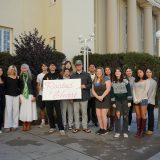
The Boulevards of Heritage Examining Ruscha's Pico and Sepulveda
September 21, 2015
September 15th to October 15th is National Hispanic Heritage Month. To celebrate, we here at Escalette would like to highlight a piece of art in our collection by Edward Ruscha entitled, Pico and Sepulveda.

Using orange, yellow, and black spots on a neutral background, Ruscha depicts the Pico and Sepulveda intersection in Los Angeles.
Ruscha has lived the majority of his life in Southern California, where he continues to live, teach, make art, and publish books to this day. His work consists of prints, paintings, and photography, and he possesses a fascination with depicting city scenes and spelling out words on neutral backgrounds, such as in his pieces Honk
and OOF. Both characteristics are present in Ruscha’s piece Pico and Sepulveda, currently on display at Chapman University.
Pico and Sepulveda is an abstract representation of a major intersection located in west Los Angeles. Sepulveda Boulevard runs from north to south. Stretching nearly 50 miles, it is the longest street in the city. Pico Boulevard runs from west to east, linking Downtown LA to the ocean. The streets’ names are derived from highly influential and historic Mexican figures; the Sepulvedas were a famous family of landowners, and Governer Pio Pico was the last Hispanic Governor of California under Mexican Rule.
The Sepulveda family’s patriarch was Francisco Xavier Sepulveda, and his two sons Francisco and Jose Antonio Andres Sepulveda are widely considered among historians to be some of the most influential figures in Californian history. Jose Andres became particularly famous for his lavish parties and skillful horsemanship. He owned the Rancho San Joaquin, which spanned from present day Laguna Beach in the south, to Newport Beach in the north, and stretched inland to what is now Red Hill Avenue. He developed something of a rivalry with Pio Pico, against whom he famously won an extravagant bet on a horse race that would become a local legend for generations.
Similarly, Governor Pio Pico was once one of the wealthiest men in Alta California, serving as the territory’s final governor before California’s annexation into the United States.
In honor of National Hispanic Heritage Month, the Escalette Permanent Collection of Art would like to recognize theses historic individuals whose lasting legacies continue to inspire.

